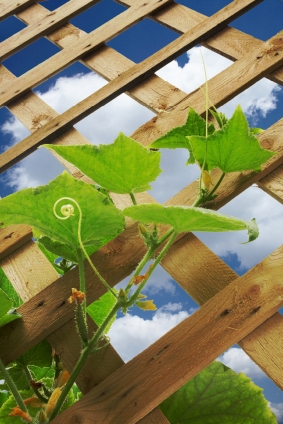Cabbage aphids wreak havoc in the garden

Cabbage aphids (Brevicoryne brassicae) can wipe out a cabbage crop before it ever gets started. Native to Europe, this pest of cole crops is now found throughout the United States.
Like other aphids, cabbage aphids are small, teardrop-shaped, sap-sucking pests that can reproduce at an alarming rate. While soft-bodied cabbage aphids are actually grayish-green, they look powdery blue to grayish-white because of a waxy covering. Cabbage aphids are not difficult to see because they live in dense colonies that can cover stems, new leaves, and entire plants practically overnight. In our moderate climate, these pests produce live offspring year-round.
Aphid defense
Cabbage aphids have an amazing defense mechanism. They produce an enzyme in their head and throat muscles which gets combined with defensive chemicals (glucosinolates) from their host plants to create an explosive chemical reaction. This reaction produces mustard oil. Unfortunately, this “walking mustard oil bomb” defense is particularly effective against ladybug larva.
Vulnerable plants
Cabbage aphids feed on the youngest, most tender parts of new cabbage, broccoli, Brussels sprouts, kale, and cauliflower. These pests also eat the innermost parts of cabbage and Brussels sprouts heads. Large colonies can stunt or even kill young plants. Heavy aphid feeding causes leaves to curl up, providing the pests with a protective cover.
Aphid controls
Prevention is key to cabbage aphid control. Row covers are an excellent way to protect young crops while they are getting established. Once aphids are seen you can often use a strong spray from the garden hose to dislodge them. If that doesn't work, insecticidal soaps can provide some control. Since some insecticidal soaps may be phytotoxic (meaning sunlight causes them to burn the plant), it is a good idea to apply them on a foggy day, especially for cabbage and Brussels sprouts.
Another way to make life more difficult for cabbage aphids is to remove any weeds in the mustard family from your property. Cabbage aphids hide out in the mustard and then return to your garden plants. Pesticides can be used as a last-ditch effort, but aphids are developing resistance to these chemicals—a potentially dangerous spiral.
Another problem with using pesticides against cabbage aphids is that those same chemicals also kill beneficial, predatory insects, such as lady beetles, parasitic wasps and syrphid flies (hoverflies). These helpful insects are natural predators of caterpillars, imported cabbage worms, diamondback moths, loopers and armyworms, which can cause other problems for your cole crops.
Monitor your plants every couple of days and be on the lookout for cabbage aphids!
by UC Master Gardener Kate Russell
Photo: South Valley Magazine
This article first appeared in the February 9, 2018 issue of the South Valley Magazine.

No, wait, I didn't mean it like that. Well, yes it's true that I'm not a big fan of complaining. But I'm all about being resourceful. So your patio isn't big enough. Or maybe you just overplanted your spacious veggie beds. And just before snap pea season! Either way, there's still hope. Beyond saving space, growing veggies vertically has many advantages. In addition to using less square footage, plants grown vertically benefit from much better air circulation which can result in fewer pests and less disease.
I saw you look over at your big blank fence. Nothing going on there. You're thinking about it, aren't you? With sturdy 8- or 10-gauge wire and some eye hooks, you can get anything from grapes to blackberries to transform that otherwise strictly utilitarian space. Pick a wire size that is strong but flexible enough for your own hand strength. Feeling like putting down roots? That big strong arbor over your back deck looks pretty bare.
If wrangling with rolls of wire is not your thing, you can try hog panels. Also known as cattle panels or feedlot panels. No matter what you call them, don't let the uninspiring terms dissuade you. Attach a few of these 5' x 7' wire sections to your fence and watch the (insert skyward climbing plant here) take off! If properly secured, these panels will provide plenty of support for just about any plant. Or perhaps you're not looking for a permanent installation. In that case, a roll of garden twine will come in handy. Lightly tap in a few nails at the top and bottom of the fence, spaced six to twelve inches apart, then run regular old garden twine up and down between the two rows of nails. Beans, peas and cucumbers will grow skyward for easy harvesting.
If you garden in containers, there is no shortage of compact trellis options that will fit perfectly inside a pot. From fancy wrought iron to practical, inexpensive wooden lattice, your local nursery will have something for all your vertically-growing veggies. Or you can go minimalist with a few bamboo stakes and some twine.
From lightweight beans and peas to the heavyweight class (sorry, the Olympics are on after all) --wisteria, grapes, kiwi and climbing roses—growing plants vertically is a sure way to add height, color and even privacy to your garden.
So no more whining about your lack of space. Grow up already!
by UC Master Gardener Cayce Hill
This article first appeared in the August 16 issue of the Morgan Hill Times.

